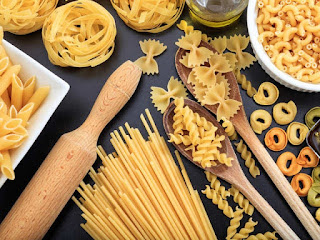Scouts and Explorers: The Pasta-bilities Are Endless
Make your own pasta, then shape it like a pro.
You will need
- Ingredients (see recipe card)
- Bowls
- Pans
- Hob
- Access to water
- Rolling pin
- Knife
Make
your pasta
Ingredients
·
200g plain flour
·
Two medium eggs
Prep time: 60
mins
Cook time: 10
mins
Serves: two
1.
Put the flour in the bowl.
2.
Make a well in the centre of the
flour and crack the eggs into it.
3.
Use your hand to draw in flour from
the edges, mixing in the centre until it’s mixed together into a solid dough.
4.
Tip out the dough and knead it into a
ball shape.
5.
Knead the dough for a minute – it
should end up being quite stiff and hard to knead.
6.
Put the dough in the fridge for 30
minutes.
7.
Cut the dough into two pieces.
8.
Choose a pasta shape and follow the
instructions below to roll, fold, or twist your pasta.
9.
Boil the pasta until it’s tender and
serve with your favourite sauce.
Fusilli
al ferretto
1.
Roll the pasta into a thin sausage.
2.
Cut the sausage into pieces about two
inches long.
3.
Put the end of one of the pieces of
pasta underneath a metal skewer, then roll the skewer forwards so the pasta
folds around it to create a spiral shape.
4.
Gently ease the piece of pasta off
the skewer.
Tagliatelle
1.
Roll the pasta out until it’s thin.
This is easier with a pasta machine, but it’s possible without.
2.
Cut the pasta so it’s a rectangle
with straight edges. The rectangle should be portrait in front of you.
3.
Add a little flour to the pasta so it
doesn’t stick.
4.
Gently roll the rectangle up from top
to bottom. Don’t roll it tight – it should be flat enough that it’s easy
to cut straight pieces of tagliatelle.
5.
Cut the roll into pieces about a
quarter of an inch wide.
6.
Open up the pasta and set it aside to
dry a little.
Farfalle
1.
Roll the pasta out until it’s thin.
This is easier with a pasta machine, but it’s possible without.
2.
Cut the pasta into strips from left
to right. The strips should be about half an inch thick.
3.
Cut the pasta into strips from top to
bottom using a serrated knife to make a bumpy edge. Make these strips about an
inch wide.
4.
Take one rectangular piece of pasta
and move it as though you’re going to fold it in half from one straight edge to
another. Before you fold it, fold the edges back on themselves and pinch it
together to make the familiar bow shape.
Reflection
This activity gave everyone the chance
to try something new. Had anyone made pasta before? How did people feel before
they got stuck in? Maybe some people were a bit apprehensive, or others thought
it wouldn’t work. What would people do if they had the chance to try another
new recipe or food?
This activity was also about living
healthily. Pasta belongs in the carbohydrate food group. Can anyone remember
why carbs are such an important part of a balanced diet? They’re our main
source of energy: they’re broken down into glucose which our bodies (especially
our brains and central nervous system) need to work. They’re also a source of
other nutrients like fibre. Can anyone think of any other tasty sources of
carbohydrates?
Safety
Cooking
Teach
young people how to use cooking equipment safely. Supervise them appropriately
throughout. Make sure it’s safe to use and follow manufacturers’ guidelines for
use.
Fires
and stoves
Make
sure anyone using fires and stoves is doing so safely. Check that the equipment
and area are suitable and have plenty of ventilation. Follow the gas safety guidance. Have
a safe way to extinguish the fire in an emergency.
Food
Check
for allergies before you begin. Make sure you have suitable areas for storing
and preparing food and avoid cross contamination of different foods.
Sharp
objects
Teach
young people how to use sharp objects safely. Supervise them appropriately
throughout. Store all sharp objects securely, out of the reach of young people.










